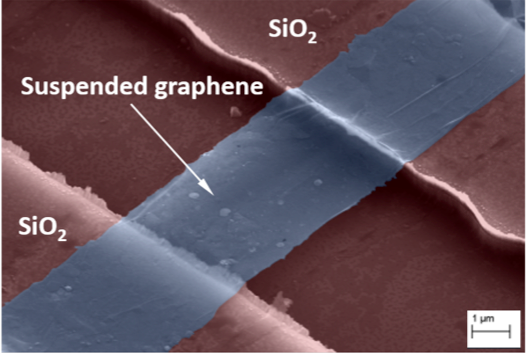Laboratory
Lab 59A AMRL
91 Technology Drive
&
C108 DEIC
81 Technology Drive
Clemson University
Anderson , SC 29625
Ph: (864) 656-2201
Dr. Koley
221-E Riggs Hall
Dept. of Electrical and Computer Engineering
Clemson University
Clemson , SC 29634
Ph: (864) 656-2201
Fax: (864) 656-5917
Visitor Count: 151202
Sensors and Electronics using graphene and other 2D materials
|
Graphene and other 2D materials present great opportunities for developing novel nanoscale sensors and electronics due to their outstanding material properties. Our research in this area is focused on harnessing some of these unique properties to develop next generation electronics and sensors with potential applications in chemical, biological and environmental sensing. The sub-focus areas within this major focus area are listed below: |
|||
|
(i) Graphene heterojunctions based electronics and sensors: |
|||
Due to its unique material properties Graphene forms interesting heterojunctions with other 2D and 3D materials that can be exploited to develop novel electronic devices and sensors. NESL is pursuing the development of sensors and electronics using graphene heterojunctions as building blocks. NESL has pioneered the concept of “chemidiode” type sensors where a reverse biased graphene/Si heterojunction was used to perform sensing with orders of magnitude higher sensitivity and lower power consumption compared to traditional chemiresistor sensors. Various chemical and biological sensing applications of the chemidiode sensor are being pursued. |

Schematic of Graphene/Si heterojunction chemidiode sensor first proposed and demonstrated by NESL in 2013 (Singh et al., Small 10, 1555, 2013).
|
||
|
(ii) 2D materials based NEMS and self-powered flexible electronics and sensors: |
|||
The flexible nature and extraordinary electronic properties of graphene and other 2D materials makes them highly promising for designing nanoelectrmechnaical systems (NEMS) and flexible electronics/sensors with multi-functionality and ultra-high performance. NESL is investigating various 2D material/polymer composites for realizing NEMS sensors, self-powered flexible electronics and bio-implantable sensors for various physiological analytes and bio-markers. |

A suspended graphene bridge on patterned SiO2 ridges on Si substrate |
||
![]()
III-Nitride MEMS based sensors
|
Microelectromechanical (MEM) devices are useful in a large variety of applications including RF Electronics and Sensors. III-Nitride semiconductors are highly promising for MEMS based sensors due to their unique spontaneous and piezoelectric polarization and chemical inertness, which can result in highly sensitive strain/deflection transduction and harsh environment operation. Our major sub-focus areas within this major focus area are listed below: |
|||
|
(i) Handheld sensor systems using III-Nitride piezotransistive microcantilevers: |
|||
|
MEMS sensors that can electronically transduce strain/deflection are highly desirable for designing integrated and array based sensor systems that consume very low power. NESL has pioneered the development of GaN based MEM sensors using ultra-sensitive “piezotransistor” or strain sensitive AlGaN/GaN HFET fabricated at the high strain region of the MEMS devices. Due to very strong polarization properties of III-Nitride MEMS they can be used to transduce ultra-small deflections down to femtoscale regime. A major research focus of our group is to exploit this extreme sensitivity and develop handheld systems for various sensing applications, including detection of nuclear and infrared radiation, and analyte molecules through photoacoustic spectroscopy. |

Piezotransistive microcantilever based highly sensitive and specific detection of analytes using photoacoustic spectroscopy (Talukdar et al., Nature Comm. 6, 7885 (2015).
|
||
|
(ii) III-Nitride microcantilever heater based miniaturized sensor systems: |
|||
Taking advantage of the polarization properties of III-Nitrides and their chemically inert nature, we have designed and fabricated novel III-Nitride based microcantilever heaters and their arrays that are capable of highly sensitive and selective detection of various analytes including volatile organic compounds. We have demonstrated, for the first time, miniaturized III-Nitride heater filament based selective detection of analytes, and our group is engaged in utilizing these microscale heaters to develop miniaturized sensor systems offering high sensitivity and selectivity as well as low power consumption. |

Triangular microcantilever heaters and their arrays for highly sensitive and selective detection of analytes (Jahangir et al., Sensors and Actuators B 222, 459 (2016)).
|
||
